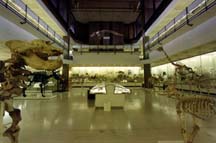home / writing /misc /
Essay on Cambridge Zoological Museum

Cambridge University is justly famous for its architecture, one of the triumphs of which must surely be the way the city centre's only tower block, the ugly concrete Cockroft building, is completely hidden from sight. It is the ultimate application of stealth technology: stealth buildings. Apart from its invisibility , the place has only one other architectural feature to recommend it. This is the large whale skeleton which hangs from a 2nd floor overhang. The whale marks the entrance to the Museum of Zoology.
 Inside is a strange mix of the amazing and the dull.
There're enough assorted uglies (including a metre long giant
spidercrab) to populate a hundred horror movies. Alongside these
are brilliantly coloured birds, stupidly big prehistoric frog
fossils, flies that dress up as bumble bees to get free honey,
and a cute, if somewhat dead, duck billed platypus.
Inside is a strange mix of the amazing and the dull.
There're enough assorted uglies (including a metre long giant
spidercrab) to populate a hundred horror movies. Alongside these
are brilliantly coloured birds, stupidly big prehistoric frog
fossils, flies that dress up as bumble bees to get free honey,
and a cute, if somewhat dead, duck billed platypus.The text accompanying these marvels of the natural world tends to be something unreadably scientific about how the ankle bones differ from species to species, so packing a natural history book might be an idea, but mixed in are some gems. There are several tales of female nastiness (usually involving doing the dinner-then-sex date the other way round) and the following description of the deep sea angler fish: "the male is active when young, but when he finds a female he fixes to her permanently and becomes a degenerate parasite... effectively just a sack with balls." An uncannily accurate description of my own behaviour at college bops.
As well as the dead and the downright extinct, there are a set of tanks with a random choice of living fish and an axolotl, a peter pan like salamander that, except in rare cases, never grows up. Anyone who's had to share a bar with a drinking society will already know that this is possible, but the university's axolotl (who I hereby name Annabelle in spite of complete ignorance on how to tell the gender of axolotls) is easily more attractive than a drinking society. There's also an exhibit labelled "Largest Living Salamander", but it's a lie. It's dead. You'd have thought zoology professors would know that nothing can survive for long in formaldehyde.
Security is non-existent, so feel free to have your photo taken being patted on the head by the elephant-dwarfing giant sloth (sadly extinct) or play chopsticks on the rhino's ribcage (second opinion needed: Do you think the horn's out of tune?). With its unrivalled collection of worms in jars, the museum is probably not the place for that all-important first date, but it will recharge even the most jaded's sense of wonder at the natural world.
During term time, the Cambridge Museum of Zoology is open to the public each weekday afternoon, 2.00pm - 4.45pm During the University vacation weekday opening times are 10am - 1pm and 2pm - 4:45pm.
© Daniel Winterstein 1998-2008
This is a personal
site. For Daniel's
business activities,
please see:
Winterwell.